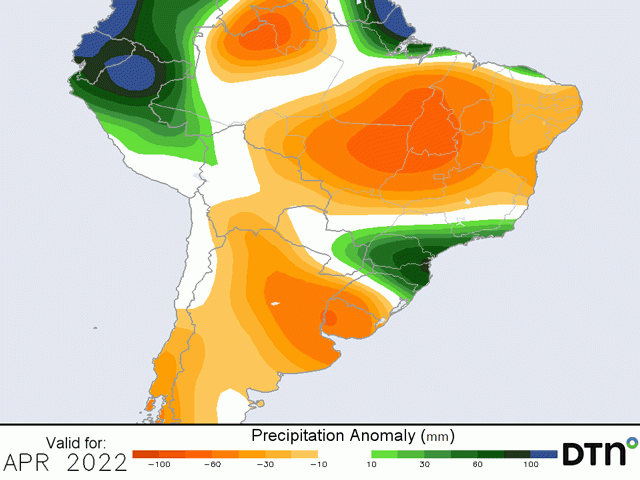Brazil Long-Range Rain Forecast
Long-Range Concerns for Safrinha Corn in Brazil
The second-season (safrinha) season was a little delayed in Brazil due to some wet weather at planting time in January and February, but most of the crop was planted within the preferred window.
According to some private estimates, around 80% of the corn was planted by the third week in February, which is the end of the preferred planting window. With the end of the wet season in central Brazil typically coming in the first few days of May, planting by that week usually allows the corn crop to get through pollination during the wet season before relying on subsoil moisture to finish out its grain-fill period.
But if the rains shut down early, or the subsoil moisture is not there, yield losses are likely to occur.
Rainfall conditions in Brazil have been a bit bipolar this growing season. Instead of widespread rains across the primary growing regions, rainfall has either come to central Brazil or southern Brazil, but rarely both at the same time. For the first-crop season, rains were almost solely focused in central Brazil, almost to a fault. Southern Brazil was incredibly dry and drought developed. This is the soybean season and production across southern zones dragged down production for the country.
However, since mid-February, the roles have become somewhat reversed. Southern Brazil has seen much better precipitation during the last several weeks, while central Brazil's showers have become much more isolated.
P[L1] D[0x0] M[300x250] OOP[F] ADUNIT[] T[]
Soil moisture has improved across southern Brazil and the safrinha corn crop is off to a good start. According to the Department of Rural Economics in the state of Parana, with 97% of the corn crop planted as of March 28, 97% of the crop is rated as "good". That is quite a difference from the soybean crop which was hovering in the 30% to 40% range for much of January and February.
In central Brazil, we are not seeing reports of any issues with the corn just yet. Soil moisture that built up during the soybean season has allowed for good germination and early growth. But the reduced rainfall during the last several weeks is starting to deplete subsoil moisture in some areas where showers have been missing more than hitting.
And this concern continues during the next couple of weeks. Occasional, isolated showers continue, but are missing more areas than they will be hitting. Overall rainfall amounts look to be below normal across the higher production areas from Mato Grosso to Minas Gerais, which account for roughly 60% of the safrinha corn production.
Models are suggesting a good week or so of rainfall toward the middle of the month but waning showers as we move into May. Of course, that is the start of the dry season. If central Brazil has only one more week of good showers left in it for the season, there should be concern that flash drought will develop while much of the crop is pollinating. We could see yield estimates falling in subsequent months.
Back to the south, the run of better showers continues. After a good burst that went through March 29-30, more are set to develop April 3-4 and another system should bring additional showers later that week. And the wet period that comes to the central portions of the country comes from the south, where better showers are forecast through at least the middle of April and likely lingering into the later portions of the month. Early development continues to look favorable for this part of the country.
However, as central Brazil's wet season ends, showers in southern Brazil also start to fade. This part of the country has had the precipitation to fill soils back up and build decent soil moisture in a lot of areas, but there are still dry spots that need filling, especially in the state of Mato Grosso do Sul.
And even if showers are good enough and soils see decent water levels going through May and their pollination period, there is one more factor that could cause a big concern for the corn crop: frost.
Under La Nina conditions, June has increased chances for seeing colder conditions move north from Argentina. Systems tend to be stronger, bringing in the colder air much farther north than normal. In June, some of the crop is still pollinating and most is filling. A killing frost could put an end to the fill period, taking the top off the yield potential. This year, frost is less of a hazard than in 2021, as much more of the crop has been planted on time. But it would still cause significant yield loss depending on when exactly it were to come, and how widespread it would be.
We still have a long way to go. And even though the early period is showing some optimism for safrinha corn in Brazil, there are always weather hazards to watch.
To find more international weather conditions and your local forecast from DTN, head over to https://www.dtnpf.com/…
John Baranick can be reached at john.baranick@dtn.com
(c) Copyright 2022 DTN, LLC. All rights reserved.




